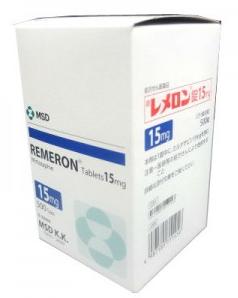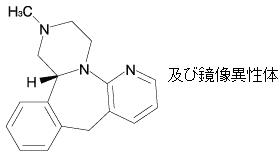英文药名:REMERON Tablets(Mirtazapine)
中文药名:米氮平片
生产厂家:MSD有限公司
レメロン錠15mg/レメロン錠30mg
治疗类别名称
去甲肾上腺素,血清素抗抑郁药
商標名
REMERON Tablets
一般名
ミルタザピン(JAN)
Mirtazapine(JAN)
化学名
(14bRS)-1,2,3,4,10,14b-Hexahydro-2-methylpyrazino[2,1-a]pyrido[2,3-c][2]benzazepine
構造式
分子式
C17H19N3
分子量
265.35
性状
是一种白色至乳白色结晶或粉末。易溶于甲醇和乙醇,和几乎不溶于水。
适应病症
抑郁症 - 抑郁症
用法用量
药片口服,如有必要可与水同服,应吞服而不应嚼碎。
成人:有效剂量通常为每日15-45mg。治疗起始剂量应为15或30毫克,(夜间应服用较高剂量)肝肾功能不良患者对米氯平的清除率有可能会降低,此类病人使用时应注意。瑞美隆的有效成分米氯平的半衰期为20至40小时,因此该药适于每日服用一次(最好在临睡前服用)。该药也可分次服用(如早晚各一次)。病人应连续服药,最好在症状完全消失四至六个月后再逐渐停药。当剂量合适时,药物应在二至四周内有显著疗效。若效果不够显著,可将剂量增加二至四周后仍无作用,应停止使用该药。
药效药理
1. 抗抗抑郁作用
(1) 抑制隔离饲养小鼠的攻击行为。
(2) 加强用大鼠DRL72操作行为药理试验采集速率。
(3) 抑制嗅球大鼠中重复给药的势头增强。
(4) 缩短在大鼠反复给药的强迫游泳试验中的不动时间。
2. 作用机序
米氮平示出了对中央的突触前α2肾上腺素受体自我和杂受体的拮抗作用,以增强两个中央羟色胺和去甲肾上腺素的神经传递。米氮平,以抑制5-HT 2和5-HT 3受体,主要是5-HT受体由血清素的神经传递的增加被激活。的S米氮平(+)对映体,主要是抑制α2受体和5-HT 2受体,R(-)对映体主要是抑制5-HT 3受体。的5-HT 3受体的N-去甲基代谢物的代谢物,仅在大鼠脑检测.alpha.2受体亲和力的5-HT 2受体和5则相当于米氮平。
包装规格
片剂
15毫克:100粒(片PTP10×10),500粒(片PTP10×50),1000片(PTP10粒×100),500片(塑料容器)
30毫克:100粒(片PTP10×10),500粒(片PTP10×50),500片(塑料容器)

制造厂商
MSD有限公司
REMERON Tablets(Mirtazapine)
REMERON Tablets 15 mg(レメロン錠15mg)
Brand name : REMERON Tablets 15 mg
Active ingredient: Mirtazapine
Dosage form: yellow tablet (major axis: 10 mm, minor axis: 6 mm, thickness: 3.5 mm)
Print on wrapping: TZ3
Effects of this medicine
This medicine enhances central noradrenergic and serotonergic activity in the brain to relieve mood and to improve symptoms such as anxiety, feeling frustrated, and sleeplessness.
It is usually used in the treatment of depression and depressed state.
Before using this medicine, be sure to tell your doctor and pharmacist
•If you have previously experienced any allergic reaction (itch, rash etc.) to any medicine.
If you are a patient with hepatic dysfunction, renal dysfunction, suicidal ideation, manic-depressive illness, organic disorder in the brain, predisposition of schizophrenia, concurrent psychiatric disorder with a strong tendency of impulsivity, heart diseases (myocardial infarction, angina pectoris, conduction block, etc.), hypotension, glaucoma, elevated intraocular pressure.
If you have a history of suicidal ideation or suicidal attempt.
If you are patient with convulsive diseases such as epilepsy or a history of them.
If you have difficulty in urinating.
•If you are pregnant or breastfeeding.
•If you are taking any other medicinal products. (Some medicines may interact to enhance or diminish medicinal effects. Beware of over-the-counter medicines and dietary supplements as well as other prescription medicines.)
Dosing schedule (How to take this medicine)
•Your dosing schedule prescribed by your doctor is <<to be written by a healthcare professional>>
•In general for adults, take 1 tablet (15 mg of the active ingredient) at a time, once a day as the initial dose, then take 1 to 2 tablets (15 to 30 mg) at a time, once a day, before going to bed. The dosage may be adjusted according to the age or symptoms, to take 3 tablets (45 mg) or lower, at a time. However, the daily dose should be increased by 1 tablet (15 mg), at intervals of 1 week or more. Strictly follow the instructions.
•If you miss a dose, take a dose as soon as possible when you remember that you missed a dose within the day. However, if it is almost time for the next dose, skip the missed dose and continue your regular dosing schedule. You should never take two doses at one time.
•If you accidentally take more than your prescribed dose, consult with your doctor or pharmacist.
•Do not stop taking this medicine unless your doctor instructs you to do so.
Precautions while taking this medicine
•Avoid the performance of potentially dangerous tasks, such as driving a car or operating machinery.
•Drinking alcohol may enhance the sedative effect of the medicine. Patients should therefore be advised to avoid alcohol beverages while taking the medicine.
•Please note that foods containing Saint John's wort may cause serotonin syndrome (anxiety, agitation, etc.) when taken concomitantly with the medicine .
•Family members of the patient should keep close contact with the doctor since the patient may develop change in his/her behavior including suicidal ideation or aggressiveness, or deterioration in underlying diseases.
Possible adverse reactions to this medicine
The most commonly reported adverse reactions include drowsiness, dry mouth, fatigue, constipation, weight gain, dizziness and headache. If any of these symptoms occur, consult with your doctor or pharmacist.
The symptoms described below are rarely seen as initial symptoms of the adverse reactions indicated in brackets. If any of these symptoms occur, stop taking this medicine and see your doctor immediately.
•anxiety, irritation, fever [serotonin syndrome]
•fever, throat pain, muscular pain [agranulocytosis, neutropenia]
•convulsion [convulsion]
•general malaise, loss of appetite, yellowing in the skin or white of the eye [hepatic dysfunction, jaundice]
•convulsion, impaired consciousness, headache [syndrome of inappropriate secretion of antidiuretic hormone]
•fever, general malaise, erythema with edema in the center [muco-cutaneo-ocular syndrome, erythema multiform]
•chest pain, uncomfortable feeling in the chest, palpitation [QT prolonged, ventricular tachycardia]
The above symptoms do not describe all the adverse reactions to this medicine. Consult with your doctor or pharmacist if you notice any symptoms of concern other than those listed above.
Storage conditions and other information
•Keep the medicine out of the reach of children. Store it away from direct sunlight, heat and moisture.
•Do not store the remainder and ask your pharmacist or medical institutions how to discard it.
http://www.info.pmda.go.jp/go/pack/1179051F1037_1_17/


